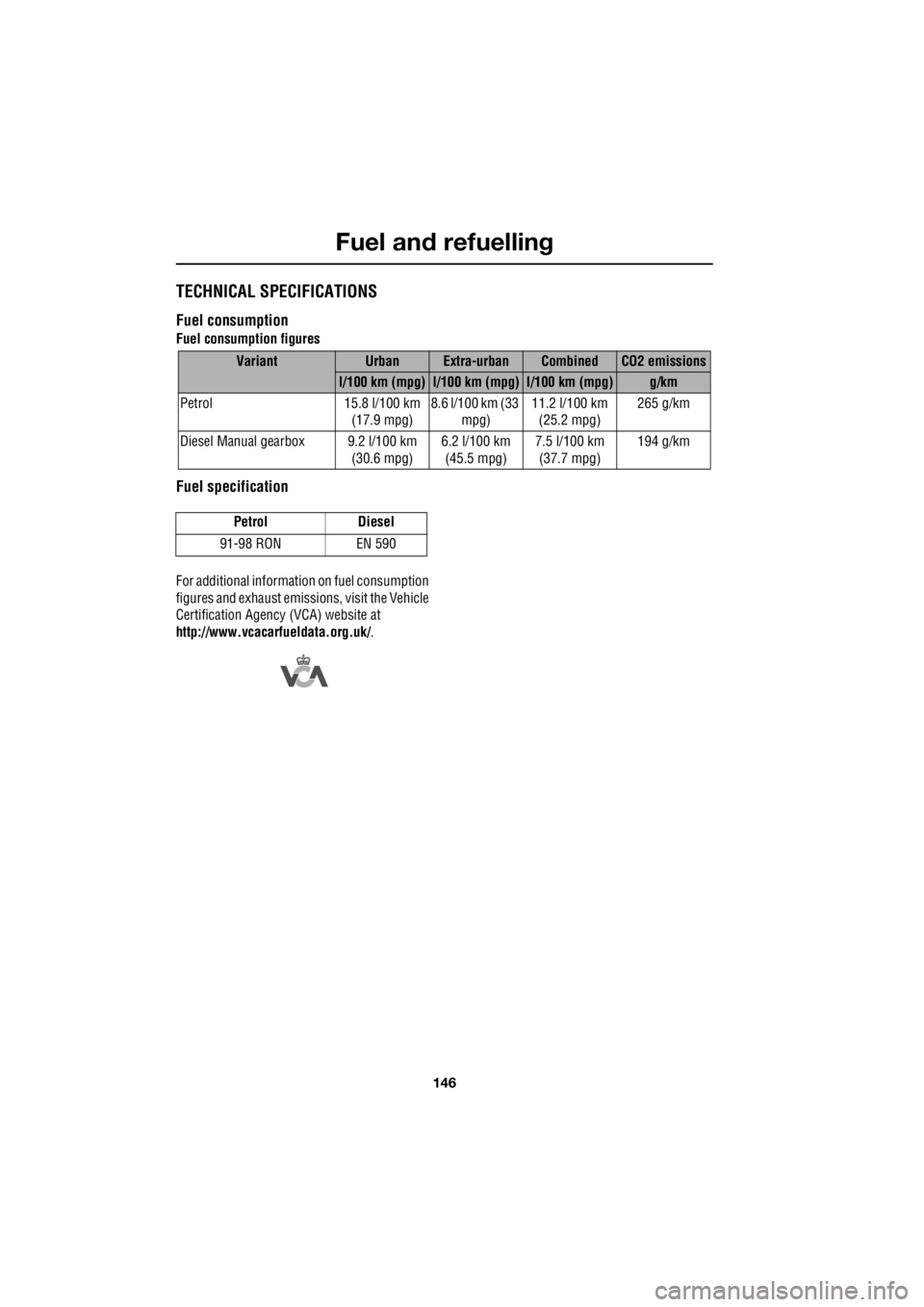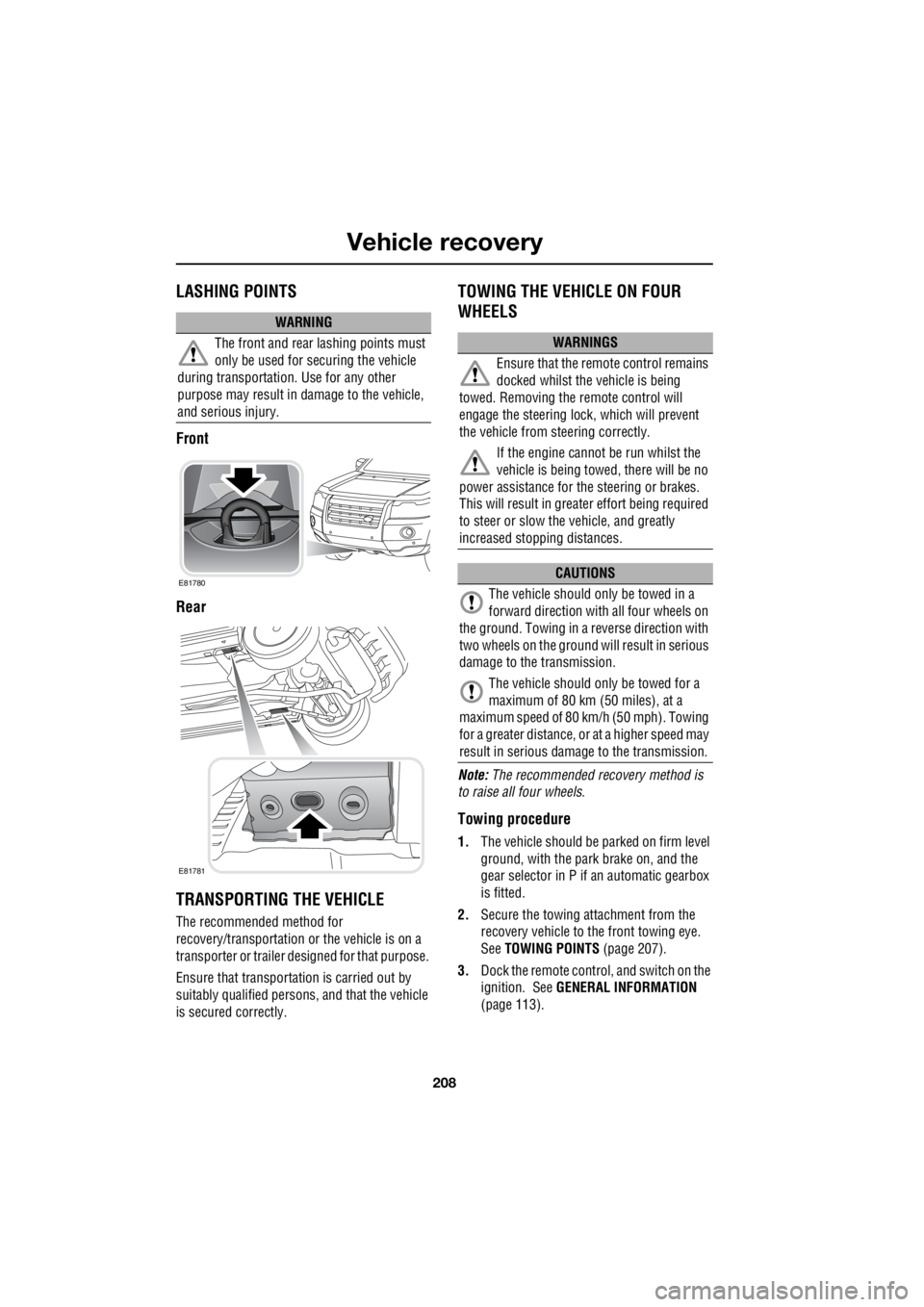2006 LAND ROVER FRELANDER 2 gearbox
[x] Cancel search: gearboxPage 2842 of 3229

Transmission
122
L
TECHNICAL SPECIFICATIONS
Transmission fluids and capacities
Transmission unit Fluid spec ification Fluid capacity
Automatic gearbox Esso JWS3309 7 litres (12.3 pints) Manual gearbox Castrol MTF 97309 1.9 litres (3.3 pints)
Power transfer unit Castrol BOT118 0.75 litres (1.3 pints) Haldex coupling STAT OIL SL01- 301 0.65 litres (1.1 pints)
Rear differential Castrol EPX 0.7 litres (1.2 pints)
Page 2844 of 3229

Brakes
124
L
ABS and off-road driving
ABS will operate when driving off-road,
however it may be unw ise to rely on it's
assistance under some conditions.
Stopping distances will be increased when
travelling over rough, or bumpy terrain.
Soft surfaces
On soft or deep surfaces such as powdery
snow, sand, or gravel, the braking distance
required will be increased. This is because the
natural action of a lock ed wheel (which cannot
happen when ABS is operating) is to form a
wedge of surface material in front of the wheel,
which reduces the stopping distance.
Steep slopes
If the vehicle is stationary on a steep, slippery
slope, it may begin to slide even with the
brakes applied. This is because without wheel
rotation the ABS cannot determine vehicle
movement.
To counteract this, briefl y release the brakes to
allow some wheel rota tion. Then re-apply the
brakes to allow ABS to gain control.
Emergency Brake Assist (EBA)
If the driver rapidly applies the brakes, EBA
automatically boosts the braking force to it's
maximum in order to bring the vehicle to a halt
as quickly as possible. If the driver applies the
brakes slowly, but condi tions mean that ABS
operates on the front wheels, EBA will increase
the braking force in order to apply ABS control
to the rear wheels.
EBA stops operating as soon as the brake pedal
is released.
A fault with the EBA system is
indicated by the red brake warning
indicator illuminating.
Electronic Brake Distribution (EBD)
EBD controls the balanc e of braking forces
supplied to the front and rear wheels, in order
to maintain maximum braking efficiency.
If the vehicle has a light load (only the driver in
the vehicle for example) the EBD will reduce the
braking force applied to the rear wheels. If the
vehicle is heavily laden then EBD will increase
the braking force to the rear wheels.
A fault with the EBD system is
indicated by the red brake warning
indicator illuminating.
PARKING BRAKE
Parking on a slope
Facing uphill
If the vehicle is parked facing uphill, select first
gear (manual gearbox), or Park (automatic
gearbox), and turn the steering wheel so that
the front wheels face away from the kerb.
Facing downhill
If the vehicle is parked facing downhill, select
reverse gear (manual gearbox), or Park
(automatic gearbox), and turn the steering
wheel so that the front wheels face towards the
kerb.
Page 2848 of 3229

Driving hints
128
L
Driving hintsGENERAL DRIVING POINTS
Battery charging - red
Illuminates as a bulb check when
the ignition is turned on and
extinguishes once the engine is
running. If it remains on, or illuminates whilst
driving, a fault with the battery charging
system is indicated. Seek qualified assistance
urgently.
Low oil pressure - red
Illuminates as a bulb check when
the ignition is turned on and
extinguishes when the engine is
started. If the indicator remains on, flashes on
and off, or illuminates whilst driving, stop the
vehicle as soon as safety permits and switch
off the engine immediat ely. Seek qualified
assistance before driving. Always check the oil
level when this indicator illuminates.
REDUCED ENGINE PERFORMANCE
Engine management syst em (EMS) fault
Illuminates amber in the
instrument pack when the engine
management system detects a
serious fault - reduce d performance may be
experienced. Avoid high speeds and consult
your Land Rover Dealer/A uthorised Repairer as
soon as possible.
Check engine - petrol models only
Illuminates amber in the
instrument pack as a bulb and
system check when the starter
switch is turned on and extinguishes as soon
as the engine is starte d. Illumination at any
other time indicates that the emission
performance of the engine management
system is impaired - seek qualified assistance.
If the indicator flashes while driving,
immediately reduce e ngine power to avoid
catalytic converter damage.
RUNNING-IN
The engine, gearbox, tyre s, and brakes need
time to bed-in. During the first 800 km (500
miles) it is essential th at the vehicle is driven
with consideration for the running-in process.
During the running in period the following
advice should be followed.
• Limit the engine speed to a maximum of
3000 rpm, and the road speed to a
maximum of 110 km/h (68 mph).
• Do not use full accelerator pedal travel, and
use the gears to avoid over-revving or
labouring the engine.
• Do not use sport mode during the running
in period.
• Avoid rapid accelerati on or heavy braking
wherever possible.
• Ensure that servicing is carried out on
time, and follow any advice regarding use
in arduous conditions.
Note: The advice given for running in will aid
fuel economy, and s hould be adopted as
general driving practice even after the running
in period.
Page 2852 of 3229

Terrain response
132
L
Terrain responsePRINCIPLE OF OPERATION
The Terrain Response System provides an
opportunity for the driver to feed back terrain
information to the vehicle by choosing a
general setting or on e of three special
programs. It then uses that information to
optimise the vehicle's systems for improved
traction and driveability. It does this by
bringing together vehicle drive control systems
which usually opera te individually.
The drive systems optimised by the Terrain
Response Syst em are :-
• Engine management.
• Gearbox management.
• Intelligent coupling control.
• Dynamic stability, trac tion and Hill Descent
controls.
The system will provide a variable accelerator
pedal response, ranging fr om very cautious for
slippery conditions (w here a large pedal
movement has only a small effect on engine
power) to very respon sive (where engine
power is allowed to rise more quickly).
Note: Changing from one special program to
another will introduce noticeably different
responses. For example, the engine revs
produced by the current accelerator pedal
position, may increase or decrease in the new
program.
To familiarise y ourself and get the best from
the system you should try out the programs in
circumstances which are safe for you and other
road users.
Terrain response has been designed to benefit
the driver no matter what their level of off-road
driving experience. The system will aid those
with less experience, a nd enhance the skills of
those with more experience.
USING TERRAIN RESPONSE
Note: The Terrain Response System is
designed to be engaged before crossing
difficult terrain. Do not wait until control has
been lost before usi ng the special programs.
When the vehicle is started, the Terrain
Response System will be in its General
program. The General program will allow the
vehicle to operate capa bly in most conditions,
as some of the sub-systems will react to the
conditions where appropriate. When
conditions change, and more difficult
conditions are encountered, the appropriate
special program should be selected.
Before driving off-road
Before venturing off-road it is absolutely
essential that inexperi enced drivers become
fully familiar with the vehicle's controls. In
particular, CommandShift , Hill Descent Control
(HDC), and the Terra in Response system.
Basic information and off-road driving
techniques can be found in the off-road driving
handbook available on-line at
http://www.ownerinfo.landrover.com
Off-road driver traini ng should be undertaken
by anyone intending to drive off-road. Training
is available at your nearest Land Rover
Experience centre. More details can be found at
http://www.landroverexperience.com
Driver override options
All systems will be se t to their optimum
parameters for the condi tions reflected in the
choice of special program. However, if
required, Hill Descent c ontrol can be operated
independently. See USING HDC (page 137). If
it has not been automatically selected by the
special program, it may be engaged as
required. Converse ly, if it has been selected,
but is not required, it may be turned off.
Page 2866 of 3229

Fuel and refuelling
146
L
TECHNICAL SPECIFICATIONS
Fuel consumption
Fuel consumption figures
Fuel specification
For additional informati on on fuel consumption
figures and exhaust emis sions, visit the Vehicle
Certification Agency (VCA) website at
http://www.vcacarfueldata.org.uk/ .
VariantUrbanExtra-urbanCombinedCO2 emissions
l/100 km (mpg)l/100 km (mpg)l/100 km (mpg)g/km
Petrol 15.8 l/100 km (17.9 mpg) 8.6 l/100 km (33
mpg) 11.2 l/100 km
(25.2 mpg) 265 g/km
Diesel Manual gearbox 9.2 l/100 km (30.6 mpg) 6.2 l/100 km
(45.5 mpg) 7.5 l/100 km
(37.7 mpg) 194 g/km
Petrol Diesel
91-98 RON EN 590
Page 2889 of 3229

169
Maintenance
R
TECHNICAL SPECIFICATIONS
Lubricants and fluids
¹ If Shell DOT4 ESL is not available, a low
viscosity DOT4 brake fl uid that meets ISO 4925
class 6 and Land Rover LRES22BF03
requirements may be used. Part Variant Specification
Engine oil Diesel vehicles SAE 5W-30 meeting Ford 913-B specification.
Engine oil Petrol vehicles SA E 0W-30 meeting ACEA A5
or B5 specification.
Main gearbox oil Manual tr ansmission Castrol MTF 97309
Main gearbox oil Automatic transmission Esso JWS3309US
Power transfer unit fluid Die sel vehicles Castrol BOT119
Power transfer unit fluid Petrol vehicles Castrol BOT118
Rear differential oil All vehicles Castrol EPX
Rear differential on demand
coupler fluid All vehicles STAT OIL SL01-301
Power steering fluid All vehicl es Pentosin CHF202 PAS fluid
Brake fluid All vehicles Shell DOT4 ESL ¹
Screen washer All vehicles Screen wash with frost protection
Coolant All vehicles 50% mixture of Texaco XLC antifreeze and water.
Page 2890 of 3229

Maintenance
170
L
Capacities
The quoted capacities are approximate and
provided as a guide only. All oil levels must be
checked using the dipsti ck or level plugs as
applicable. Item Variant Capacity
Fuel tank Diesel vehi cles 68 litres (15 gallons)
Petrol vehicles 70 litres (15.4 gallons)
Engine oil refill and filter change Di esel vehicles 5.86 litres (10.31 pints)
Petrol vehicles 7.7 litres (13.55 pints)
Engine oil MIN to MAX on
dipstick Diesel vehicles 1.5
litres (2.64 pints)
Petrol vehicles 0.8 litres (1.4 pints)
Manual gearbox All vehicles 2.0 litres (3.52 pints)
Automatic gearbox All vehicl es 7 litres (12.32 pints)
Power transfer unit All vehi cles 0.75 litres (1.32 pints)
Rear differential All vehi cles 0.7 litres (1.23 pints)
Rear differential coupling unit All vehicles 0.65 litres (1.14 pints)
Washer reservoir With headlamp wash 5.8 litres (10.2 pints)
Washer reservoir Without headla mp wash 3.1 litres (5.45 pints)
Cooling system (fill from dry) Al l vehicles 8.0 litres (14.07 pints)
Page 2928 of 3229

Vehicle recovery
208
L
LASHING POINTS
Front
Rear
TRANSPORTING THE VEHICLE
The recommended method for
recovery/transportation or the vehicle is on a
transporter or trailer de signed for that purpose.
Ensure that transporta tion is carried out by
suitably qualified persons , and that the vehicle
is secured correctly.
TOWING THE VEHICLE ON FOUR
WHEELS
Note: The recommended recovery method is
to raise all four wheels.
Towing procedure
1. The vehicle should be parked on firm level
ground, with the park brake on, and the
gear selector in P if an automatic gearbox
is fitted.
2. Secure the towing attachment from the
recovery vehicle to the front towing eye.
See TOWING POINTS (page 207).
3. Dock the remote control, and switch on the
ignition. See GENERAL INFORMATION
(page 113).
WARNING
The front and rear lashing points must
only be used for securing the vehicle
during transportation. Use for any other
purpose may result in da mage to the vehicle,
and serious injury.
E81780
E81781
WARNINGS
Ensure that the remote control remains
docked whilst the vehicle is being
towed. Removing the remote control will
engage the steering lo ck, which will prevent
the vehicle from steering correctly.
If the engine cannot be run whilst the
vehicle is being towed, there will be no
power assistance for the steering or brakes.
This will result in grea ter effort being required
to steer or slow the vehicle, and greatly
increased stopping distances.
CAUTIONS
The vehicle should only be towed in a
forward direction with all four wheels on
the ground. Towing in a reverse direction with
two wheels on the ground will result in serious
damage to the transmission.
The vehicle should only be towed for a
maximum of 80 km (50 miles), at a
maximum speed of 80 k m/h (50 mph). Towing
for a greater distance, or at a higher speed may
result in serious dama ge to the transmission.